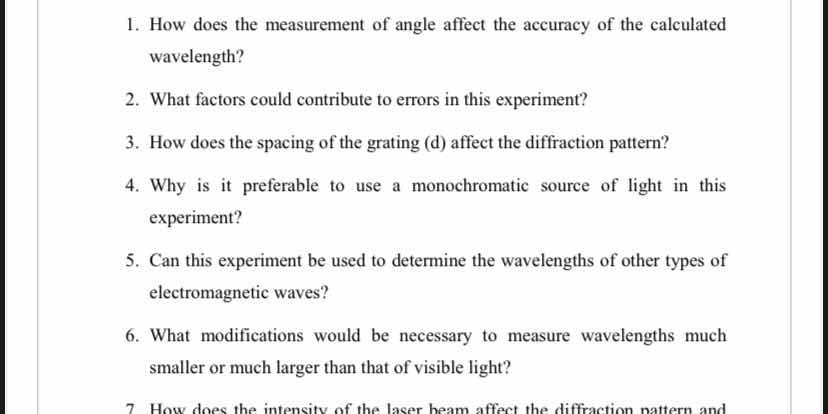1. How does the measurement of angle affect the accuracy of the calculated wavelength? 2. What factors could contribute to errors in this experiment? 3. How does the spacing of the... 1. How does the measurement of angle affect the accuracy of the calculated wavelength? 2. What factors could contribute to errors in this experiment? 3. How does the spacing of the grating (d) affect the diffraction pattern? 4. Why is it preferable to use a monochromatic source of light in this experiment? 5. Can this experiment be used to determine the wavelengths of other types of electromagnetic waves? 6. What modifications would be necessary to measure wavelengths much smaller or much larger than that of visible light? 7. How does the intensity of the laser beam affect the diffraction pattern and the resulting measurements?

Understand the Problem
The questions are asking about various aspects related to a diffraction experiment, including the influence of angle measurement on wavelength accuracy, potential sources of error, effects of grating spacing, and the applicability of the experiment to various types of electromagnetic waves.
Answer
1. Angle precision affects wavelength accuracy. 2. Errors: angle inaccuracies, grating issues. 3. Larger d gives smaller angles. 4. Monochromatic light avoids wavelength mix. 5. Yes, with modifications. 6. Different detectors/sources needed. 7. Intensity affects contrast, not positions.
- The precision in angle measurement directly affects the calculated wavelength due to the dependence on the sine of the angle in the diffraction formula. 2. Errors can arise from incorrect angle measurement, imperfect grating alignment, and environmental factors. 3. Grating spacing affects diffraction angles and spacing of the pattern, with larger spacings resulting in smaller angles. 4. Monochromatic light provides a single wavelength, eliminating complexities from multiple wavelengths. 5. Yes, but modifications are needed for non-visible wavelengths. 6. For much smaller wavelengths, different detectors and safety precautions are needed; for larger, consider different diffraction materials or configurations. 7. Intensity affects pattern contrast but not the position of diffraction maxima.
Answer for screen readers
- The precision in angle measurement directly affects the calculated wavelength due to the dependence on the sine of the angle in the diffraction formula. 2. Errors can arise from incorrect angle measurement, imperfect grating alignment, and environmental factors. 3. Grating spacing affects diffraction angles and spacing of the pattern, with larger spacings resulting in smaller angles. 4. Monochromatic light provides a single wavelength, eliminating complexities from multiple wavelengths. 5. Yes, but modifications are needed for non-visible wavelengths. 6. For much smaller wavelengths, different detectors and safety precautions are needed; for larger, consider different diffraction materials or configurations. 7. Intensity affects pattern contrast but not the position of diffraction maxima.
More Information
Accurate angle measurements are crucial due to their exponential effect on wavelength calculations. Using monochromatic sources ensures consistency across measurements, while facilitating adaptability for other wavelengths requires instrument modifications.
Tips
Common mistakes include inaccurate angle measurements and overlooking environmental factors, which can both significantly skew results. Consistent calibration and controlled environments can help minimize these errors.
Sources
- What are possible sources of errors in a diffraction grating ... - Quora - quora.com
- Solved v Effect of Slit Spacing on the Diffraction Pattern | Chegg.com - chegg.com
- The Feynman Lectures on Physics Vol. I Ch. 30: Diffraction - feynmanlectures.caltech.edu
AI-generated content may contain errors. Please verify critical information